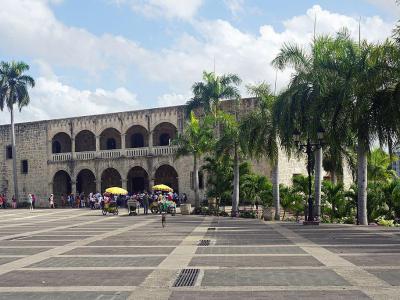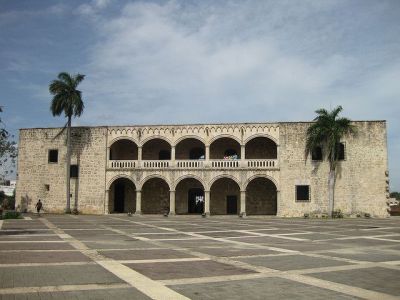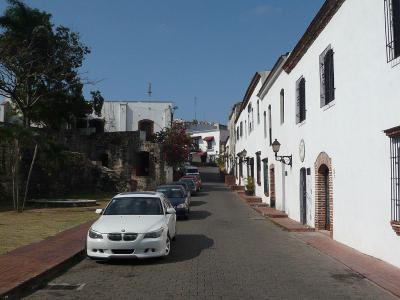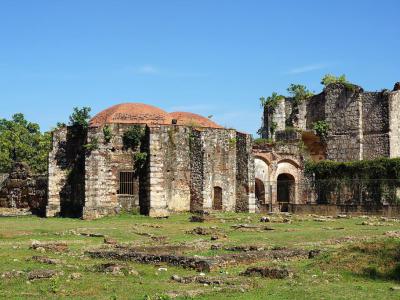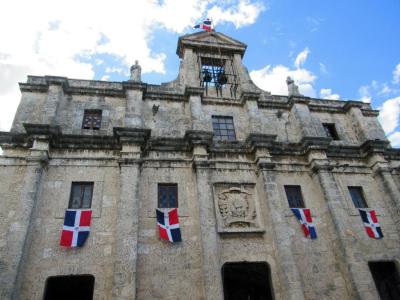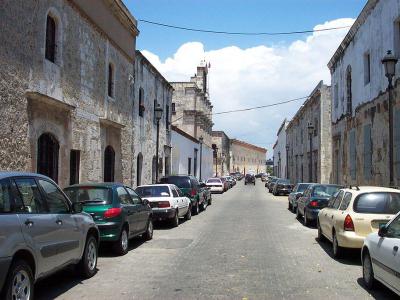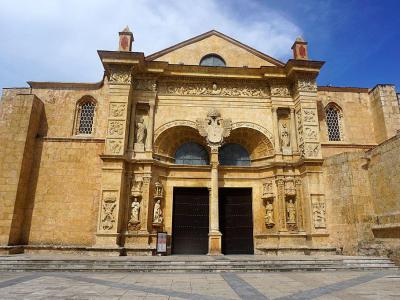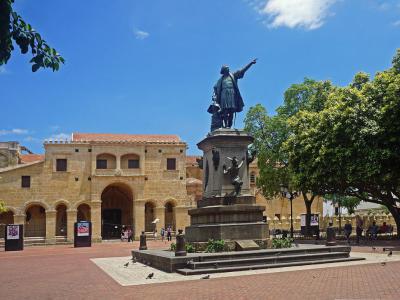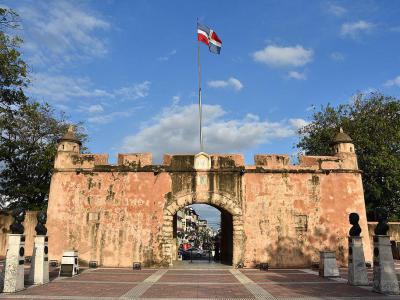Santo Domingo Introduction Walking Tour (Self Guided), Santo Domingo
The capital of the Dominican Republic, Santo Domingo, or simply "La Capital" as the locals commonly refer to it, holds the distinction of being the oldest continuously inhabited European settlement in the Americas.
Founded in 1496 by Bartholomew Columbus, Christopher Columbus's younger brother, it was originally called "La Nueva Isabela", but was soon renamed Santo Domingo in honor of Saint Dominic, the founder of the Dominican Order.
During the early colonial period, Santo Domingo was an important center for Spanish influence in the New World. It served as the launching point for expeditions to other parts of the Caribbean and mainland Americas. However, over time, the city's prominence diminished as other Spanish colonies gained importance.
In the 17th century, Santo Domingo faced a series of challenges, including pirate attacks and conflicts with other European powers. The city was even briefly occupied by the English, but ultimately returned to Spanish control. The Dominican Republic achieved independence in 1844, with Santo Domingo as its capital.
Today, Santo Domingo's historic district, known as the Colonial Zone (Zona Colonial), is a UNESCO World Heritage Site. Surrounded by walls, it preserves the early settlers' legacy manifested in cobblestoned streets and centuries-old buildings, some dating back as far as the 1500s. Among the well-preserved examples of Spanish colonial architecture here is the Cathedral of Santa María la Menor, the first cathedral built in the New World.
An opulent testimony to the legacy of Christopher Columbus, the Columbus Palace (Alcázar de Colón) in Spanish Square (Plaza de España) holds one of the city’s numerous museums.
Another prominent landmark, the National Pantheon (Panteón Nacional) beckons as a hallowed sanctuary of commemoration, cradling the remains of luminaries who shaped the nation's destiny.
Ladies Street (Calle Las Damas) bears a name that is as evocative as its charm. A living vestige of antiquity, it is lined with historic buildings, including the former residences of colonial nobility.
Embarking upon a journey through Santo Domingo, the resplendent narrative of the city unfolds with every footfall, invoking reflections upon its inception and evolution. Each edifice here is a chapter in an ongoing tale, inviting discerning travelers to traverse the corridors of history and connect with the soul of a city that holds the keys to the New World's heart. To discover the echoes of the past that reverberate through the present, and let the spirit of Santo Domingo ignite your own journey of exploration and understanding, take this self-guided walk.
Founded in 1496 by Bartholomew Columbus, Christopher Columbus's younger brother, it was originally called "La Nueva Isabela", but was soon renamed Santo Domingo in honor of Saint Dominic, the founder of the Dominican Order.
During the early colonial period, Santo Domingo was an important center for Spanish influence in the New World. It served as the launching point for expeditions to other parts of the Caribbean and mainland Americas. However, over time, the city's prominence diminished as other Spanish colonies gained importance.
In the 17th century, Santo Domingo faced a series of challenges, including pirate attacks and conflicts with other European powers. The city was even briefly occupied by the English, but ultimately returned to Spanish control. The Dominican Republic achieved independence in 1844, with Santo Domingo as its capital.
Today, Santo Domingo's historic district, known as the Colonial Zone (Zona Colonial), is a UNESCO World Heritage Site. Surrounded by walls, it preserves the early settlers' legacy manifested in cobblestoned streets and centuries-old buildings, some dating back as far as the 1500s. Among the well-preserved examples of Spanish colonial architecture here is the Cathedral of Santa María la Menor, the first cathedral built in the New World.
An opulent testimony to the legacy of Christopher Columbus, the Columbus Palace (Alcázar de Colón) in Spanish Square (Plaza de España) holds one of the city’s numerous museums.
Another prominent landmark, the National Pantheon (Panteón Nacional) beckons as a hallowed sanctuary of commemoration, cradling the remains of luminaries who shaped the nation's destiny.
Ladies Street (Calle Las Damas) bears a name that is as evocative as its charm. A living vestige of antiquity, it is lined with historic buildings, including the former residences of colonial nobility.
Embarking upon a journey through Santo Domingo, the resplendent narrative of the city unfolds with every footfall, invoking reflections upon its inception and evolution. Each edifice here is a chapter in an ongoing tale, inviting discerning travelers to traverse the corridors of history and connect with the soul of a city that holds the keys to the New World's heart. To discover the echoes of the past that reverberate through the present, and let the spirit of Santo Domingo ignite your own journey of exploration and understanding, take this self-guided walk.
How it works: Download the app "GPSmyCity: Walks in 1K+ Cities" from Apple App Store or Google Play Store to your mobile phone or tablet. The app turns your mobile device into a personal tour guide and its built-in GPS navigation functions guide you from one tour stop to next. The app works offline, so no data plan is needed when traveling abroad.
Santo Domingo Introduction Walking Tour Map
Guide Name: Santo Domingo Introduction Walking Tour
Guide Location: Dominican Republic » Santo Domingo (See other walking tours in Santo Domingo)
Guide Type: Self-guided Walking Tour (Sightseeing)
# of Attractions: 10
Tour Duration: 2 Hour(s)
Travel Distance: 2.5 Km or 1.6 Miles
Author: alex1007
Sight(s) Featured in This Guide:
Guide Location: Dominican Republic » Santo Domingo (See other walking tours in Santo Domingo)
Guide Type: Self-guided Walking Tour (Sightseeing)
# of Attractions: 10
Tour Duration: 2 Hour(s)
Travel Distance: 2.5 Km or 1.6 Miles
Author: alex1007
Sight(s) Featured in This Guide:
- Plaza España (Spanish Square)
- Alcázar de Colón (Columbus Alcazar)
- La Atarazana Street
- Monasterio de San Francisco (Saint Francis Monastery)
- Panteón Nacional (National Pantheon)
- Calle Las Damas (Ladies Street)
- Cathedral of Santa Maria la Menor
- Parque Colon (Colon Park)
- Calle el Conde (Count Street)
- Puerta Del Conde (Count's Gate)
1) Plaza España (Spanish Square)
Spanish Square is a historic and lively square situated in front of the impressive Columbus Fortress. The square holds significant cultural and architectural value. It provides visitors with a glimpse into the rich history of the city and offers a charming ambiance for locals and tourists alike.
At the heart of the square stands the statue of Nicolás de Ovando, the founder of Santo Domingo, paying homage to the city's historical origins. This monument serves as a reminder of the city's colonial past and the importance of its foundation.
Adjacent to the statue, on the western bank of the river, stands a remarkable sun clock dating back to 1753. This ancient timekeeping device not only adds to the aesthetic appeal of the square but also showcases the ingenuity and engineering prowess of its time.
Upon entering the Spanish Square, visitors are greeted by a scenic view towards the north, where de La Atarazana Street awaits. This street is a picturesque and historically significant pathway leading to the Royal Dockyards, a collection of buildings erected during the 15th and 16th centuries.
The atmosphere surrounding Spanish Square is one of excitement and conviviality. The square is enveloped by an array of bars and restaurants that set up their inviting terraces, especially during twilight. This provides an excellent opportunity for visitors to immerse themselves in the lively and exuberant "typical Dominican party" culture.
While in Spanish Square, tourists and locals alike are encouraged to take in the grandeur of the Colonial style architecture that surrounds the area. The blend of old-world charm and modern amenities creates a unique and enchanting environment that captures the essence of Santo Domingo's cultural heritage.
At the heart of the square stands the statue of Nicolás de Ovando, the founder of Santo Domingo, paying homage to the city's historical origins. This monument serves as a reminder of the city's colonial past and the importance of its foundation.
Adjacent to the statue, on the western bank of the river, stands a remarkable sun clock dating back to 1753. This ancient timekeeping device not only adds to the aesthetic appeal of the square but also showcases the ingenuity and engineering prowess of its time.
Upon entering the Spanish Square, visitors are greeted by a scenic view towards the north, where de La Atarazana Street awaits. This street is a picturesque and historically significant pathway leading to the Royal Dockyards, a collection of buildings erected during the 15th and 16th centuries.
The atmosphere surrounding Spanish Square is one of excitement and conviviality. The square is enveloped by an array of bars and restaurants that set up their inviting terraces, especially during twilight. This provides an excellent opportunity for visitors to immerse themselves in the lively and exuberant "typical Dominican party" culture.
While in Spanish Square, tourists and locals alike are encouraged to take in the grandeur of the Colonial style architecture that surrounds the area. The blend of old-world charm and modern amenities creates a unique and enchanting environment that captures the essence of Santo Domingo's cultural heritage.
2) Alcázar de Colón (Columbus Alcazar) (must see)
The Columbus Alcazar is a historically significant and awe-inspiring edifice located in Santo Domingo. As the oldest Viceregal residence in the Americas, it holds a prestigious place within the Colonial Zone of Santo Domingo, a UNESCO World Heritage Site.
The Columbus Alcazar houses the Alcazar Museum of Diego Colón, which boasts an exceptional collection of European late medieval and Renaissance works of art. Acquired in the 1950s, these art pieces represent the most important ensemble of their kind in the Caribbean region. Among the notable exhibits is a Tapestry collection that spans the 15th to 17th centuries, making it particularly unique and significant in the Caribbean. This collection includes remarkable pieces produced by the renowned Flemish Van Den Hecke family, using cartouches created by Charles Le Brun. As a result, the museum attracts a considerable number of visitors and stands as the most visited museum in Santo Domingo.
The palace itself is a stunning architectural marvel, constructed with coralline blocks. In its heyday, it boasted around fifty rooms, gardens, and courtyards, creating a grand and opulent atmosphere befitting a Viceregal residence. However, today, only about half of its original size remains due to the passage of time and historical events. The Alcázar de Colón was built during the early 16th century, between 1510 and 1512, under the orders of Diego Colón, the son of Christopher Columbus. At the time, Diego Colón served as the Viceroy of La Española and the Indies, and he envisioned the mansion as both a family home and a governor's mansion.
Throughout the Spanish colonial period, the Columbus Alcazar held immense importance in history. It served as a crucial center for planning expeditions of conquest and exploration, shaping the course of early exploration and colonization in the region.
Editor's note: The Alcazar Museum is temporarily closed.
The Columbus Alcazar houses the Alcazar Museum of Diego Colón, which boasts an exceptional collection of European late medieval and Renaissance works of art. Acquired in the 1950s, these art pieces represent the most important ensemble of their kind in the Caribbean region. Among the notable exhibits is a Tapestry collection that spans the 15th to 17th centuries, making it particularly unique and significant in the Caribbean. This collection includes remarkable pieces produced by the renowned Flemish Van Den Hecke family, using cartouches created by Charles Le Brun. As a result, the museum attracts a considerable number of visitors and stands as the most visited museum in Santo Domingo.
The palace itself is a stunning architectural marvel, constructed with coralline blocks. In its heyday, it boasted around fifty rooms, gardens, and courtyards, creating a grand and opulent atmosphere befitting a Viceregal residence. However, today, only about half of its original size remains due to the passage of time and historical events. The Alcázar de Colón was built during the early 16th century, between 1510 and 1512, under the orders of Diego Colón, the son of Christopher Columbus. At the time, Diego Colón served as the Viceroy of La Española and the Indies, and he envisioned the mansion as both a family home and a governor's mansion.
Throughout the Spanish colonial period, the Columbus Alcazar held immense importance in history. It served as a crucial center for planning expeditions of conquest and exploration, shaping the course of early exploration and colonization in the region.
Editor's note: The Alcazar Museum is temporarily closed.
3) La Atarazana Street
La Atarazana Street is a delightful destination for shopping and immersing oneself in the city's rich history and vibrant culture. This charming street offers a unique blend of modern establishments and historical significance, making it an interesting spot for locals and tourists alike.
For shopping enthusiasts, La Atarazana is a paradise. The street is lined with a variety of shops, including art galleries, jewelry stores, and shops offering vintage crafts. As you stroll along this picturesque street, you'll find yourself captivated not only by the diverse and exquisite items available for sale but also by the enchanting views of the surrounding area.
La Atarazana Street is not only a shopper's haven but also a historical pathway with deep cultural roots. It leads to the Royal Dockyards, a collection of buildings that date back to the 15th and 16th centuries. Originally designed as storages, these structures have undergone a fascinating transformation over time. Today, they house a vibrant array of establishments, such as restaurants, discos, art galleries, and more. The blending of modern activities within these centuries-old buildings creates an incredible atmosphere where history and contemporary life harmoniously coexist.
Despite the modern renovations, the exterior facades of the Royal Dockyards have been meticulously preserved. This preservation allows visitors to witness and appreciate the historical charm that emanates from these ancient structures. The juxtaposition of the past and present creates a unique experience for those exploring La Atarazana Street and the Royal Dockyards.
For shopping enthusiasts, La Atarazana is a paradise. The street is lined with a variety of shops, including art galleries, jewelry stores, and shops offering vintage crafts. As you stroll along this picturesque street, you'll find yourself captivated not only by the diverse and exquisite items available for sale but also by the enchanting views of the surrounding area.
La Atarazana Street is not only a shopper's haven but also a historical pathway with deep cultural roots. It leads to the Royal Dockyards, a collection of buildings that date back to the 15th and 16th centuries. Originally designed as storages, these structures have undergone a fascinating transformation over time. Today, they house a vibrant array of establishments, such as restaurants, discos, art galleries, and more. The blending of modern activities within these centuries-old buildings creates an incredible atmosphere where history and contemporary life harmoniously coexist.
Despite the modern renovations, the exterior facades of the Royal Dockyards have been meticulously preserved. This preservation allows visitors to witness and appreciate the historical charm that emanates from these ancient structures. The juxtaposition of the past and present creates a unique experience for those exploring La Atarazana Street and the Royal Dockyards.
4) Monasterio de San Francisco (Saint Francis Monastery) (must see)
The Monastery of San Francisco is a historically significant and cherished site in the heart of the Zona Colonial. Its construction dates back to around 1508, coinciding with the arrival of the Franciscan fathers, making it the first monastery in the New World. Despite its current state of ruin, it remains one of the most important and treasured landmarks in the city, earning its designation as a "heritage Dominican."
The monastery was commissioned by Nicolas de Ovando, and its construction began with the arrival of the Franciscan fathers in the early 16th century. However, it faced challenges throughout its history. The main part of the church was constructed in 1544 and completed on July 23, 1556. Tragically, it suffered severe damage from a hurricane and was subsequently looted by the infamous pirate Francis Drake in 1586. Repairs were carried out in 1664, but further damage occurred due to earthquakes in 1673 and 1751.
The monastery's historical significance is further enhanced by the notable figures associated with it. Historians believe that the remains of Alonso de Ojeda, a renowned explorer, were once buried at the main entrance to the monastery. Additionally, the remains of Bartholomew Columbus, Christopher Columbus's brother, were also found within its grounds. These connections with prominent historical figures contribute to the site's allure for history enthusiasts.
Over the centuries, the Monastery of San Francisco witnessed various uses and underwent different phases of restoration. During the Battle of Palo Hincado in 1808 against the French, the building served as a strategic military position with a piece of artillery deployed on its roof. However, the vault was damaged in the process, and a timber platform was constructed to accommodate the military operations.
In the late 19th and early 20th centuries, the monastery served as a mental asylum. Unfortunately, a hurricane during that period caused substantial damage that was never fully repaired, leading to the current state of ruin. Today, the majestic ruins are used for social and cultural events, showcasing the enduring importance of this historical site in the cultural life of Santo Domingo.
The monastery was commissioned by Nicolas de Ovando, and its construction began with the arrival of the Franciscan fathers in the early 16th century. However, it faced challenges throughout its history. The main part of the church was constructed in 1544 and completed on July 23, 1556. Tragically, it suffered severe damage from a hurricane and was subsequently looted by the infamous pirate Francis Drake in 1586. Repairs were carried out in 1664, but further damage occurred due to earthquakes in 1673 and 1751.
The monastery's historical significance is further enhanced by the notable figures associated with it. Historians believe that the remains of Alonso de Ojeda, a renowned explorer, were once buried at the main entrance to the monastery. Additionally, the remains of Bartholomew Columbus, Christopher Columbus's brother, were also found within its grounds. These connections with prominent historical figures contribute to the site's allure for history enthusiasts.
Over the centuries, the Monastery of San Francisco witnessed various uses and underwent different phases of restoration. During the Battle of Palo Hincado in 1808 against the French, the building served as a strategic military position with a piece of artillery deployed on its roof. However, the vault was damaged in the process, and a timber platform was constructed to accommodate the military operations.
In the late 19th and early 20th centuries, the monastery served as a mental asylum. Unfortunately, a hurricane during that period caused substantial damage that was never fully repaired, leading to the current state of ruin. Today, the majestic ruins are used for social and cultural events, showcasing the enduring importance of this historical site in the cultural life of Santo Domingo.
5) Panteón Nacional (National Pantheon) (must see)
The National Pantheon is a significant historical and cultural landmark with a storied past that spans centuries. Originally built from 1714 to 1746 by the Spaniard Geronimo Quezada y Garçon, the structure started as a Jesuit church, showcasing the neoclassic-renaissance architectural style.
Today, the National Pantheon stands as a proud national symbol of the Dominican Republic and holds a profound role as the final resting place for the country's most esteemed citizens. Initially serving as a place of worship, the Jesuits conducted masses within its walls from 1746 to 1767. However, its purpose evolved over time, and after 1767, it went through various uses, including functioning as a tobacco warehouse and a theater.
The theater within the National Pantheon became a crucial hub for the pro-independence organization La Trinitaria. Under the guise of aliases like La Filantrópica and La Dramática, national heroes such as Juan Pablo Duarte, Ramon Matias Mella, and Francisco del Rosario Sanchez, among others, expressed their ideas and aspirations for a free and sovereign republic. From this stage, the seeds of independence and nationalism were sown, paving the way for the country's eventual liberation.
In 1956, the National Pantheon underwent renovations by Spanish architect Javier Borroso to transform it into a national mausoleum, under the order of then dictator Rafael Trujillo. Ironically, Trujillo initially envisioned being buried at the National Pantheon, but today it serves as the resting place for the Dominican Republic's most celebrated individuals, including some of Trujillo's assassins. Notable figures interred at the National Pantheon include Francisco Gregorio Billini, Gregorio Luperón, and Eugenio Hostos, among others.
Today, the National Pantheon stands as a proud national symbol of the Dominican Republic and holds a profound role as the final resting place for the country's most esteemed citizens. Initially serving as a place of worship, the Jesuits conducted masses within its walls from 1746 to 1767. However, its purpose evolved over time, and after 1767, it went through various uses, including functioning as a tobacco warehouse and a theater.
The theater within the National Pantheon became a crucial hub for the pro-independence organization La Trinitaria. Under the guise of aliases like La Filantrópica and La Dramática, national heroes such as Juan Pablo Duarte, Ramon Matias Mella, and Francisco del Rosario Sanchez, among others, expressed their ideas and aspirations for a free and sovereign republic. From this stage, the seeds of independence and nationalism were sown, paving the way for the country's eventual liberation.
In 1956, the National Pantheon underwent renovations by Spanish architect Javier Borroso to transform it into a national mausoleum, under the order of then dictator Rafael Trujillo. Ironically, Trujillo initially envisioned being buried at the National Pantheon, but today it serves as the resting place for the Dominican Republic's most celebrated individuals, including some of Trujillo's assassins. Notable figures interred at the National Pantheon include Francisco Gregorio Billini, Gregorio Luperón, and Eugenio Hostos, among others.
6) Calle Las Damas (Ladies Street) (must see)
Ladies Street holds a significant place in the history of Santo Domingo. As the first street in the city and in the Americas, it carries with it a rich heritage that reflects the colonial past of the region.
Situated within the enchanting Colonial City, Ladies Street derives its name from the fact that it was frequented by the ladies of the colony during its early days. Today, the street is adorned with colonial tiles, creating a charming and picturesque atmosphere.
Ladies Street boasts several colonial houses, some of which still display their original colonial shields. These houses were built by distinguished families of the colonial period, including the Oviedo, Dávila, Heredia, Campuzano Polanco, Infante, and Coca families.
At the end of Ladies Street lies the Spanish Square, a vibrant and bustling square that marks the culmination of this historic street. The plaza offers a picturesque setting for locals and tourists to gather, relax, and soak in the ambiance of the Colonial Zone.
The origins of Ladies Street can be traced back to the government of Nicolás de Ovando, during which it became the first street created in the Colonial Zone. Originally known as Fortress Street due to the presence of the Ozama Fortress, the street later acquired the name Ladies Street. Despite a brief period when it was renamed Colón Street in honor of Christopher Columbus, the street ultimately reclaimed its original name.
Situated within the enchanting Colonial City, Ladies Street derives its name from the fact that it was frequented by the ladies of the colony during its early days. Today, the street is adorned with colonial tiles, creating a charming and picturesque atmosphere.
Ladies Street boasts several colonial houses, some of which still display their original colonial shields. These houses were built by distinguished families of the colonial period, including the Oviedo, Dávila, Heredia, Campuzano Polanco, Infante, and Coca families.
At the end of Ladies Street lies the Spanish Square, a vibrant and bustling square that marks the culmination of this historic street. The plaza offers a picturesque setting for locals and tourists to gather, relax, and soak in the ambiance of the Colonial Zone.
The origins of Ladies Street can be traced back to the government of Nicolás de Ovando, during which it became the first street created in the Colonial Zone. Originally known as Fortress Street due to the presence of the Ozama Fortress, the street later acquired the name Ladies Street. Despite a brief period when it was renamed Colón Street in honor of Christopher Columbus, the street ultimately reclaimed its original name.
7) Cathedral of Santa Maria la Menor (must see)
The Cathedral of Santa María la Menor holds a prominent place in history as the oldest cathedral in the Americas. Dedicated to Saint Mary of the Incarnation, the cathedral's historical significance, exquisite architecture, and impressive art collection make it a must-visit destination for travelers seeking to immerse themselves in the rich cultural heritage of the region.
The cathedral's facade, fronted with golden-tinted coral limestone, is a sight to behold. Its architectural style is a harmonious blend of Gothic and Baroque elements, complemented by lavish plateresque designs. The high altar, crafted out of silver, stands as a prime example of the cathedral's opulence and devotion to artistic expression.
Within the Cathedral of Santa María la Menor lies a treasure trove of art, displayed in its treasury. The collection includes ancient woodcarvings, ornate furnishings, funerary monuments, silverware, and exquisite jewelry. These artistic masterpieces provide a glimpse into the craftsmanship and devotion of the artists and patrons throughout the centuries.
The cathedral's rich history can be traced back to its consecration by Pope Julius II in 1504. Construction began in 1512 under the leadership of Bishop Fray García Padilla, with the skilled hands of Luis Moya guiding the process. The result is an architectural marvel with twelve side chapels, three aisles, and a nave. The pitched roof of the nave and cross-vaulted ceilings of the aisles add to the grandeur and magnificence of the interior.
Stepping inside the Cathedral of Santa María la Menor, visitors are transported to a bygone era. The sight of retablos, paintings, old woodwork, furniture, sculptures, and tombstones in the treasury leaves a lasting impression, representing centuries of religious devotion and artistic expression.
The cathedral's facade, fronted with golden-tinted coral limestone, is a sight to behold. Its architectural style is a harmonious blend of Gothic and Baroque elements, complemented by lavish plateresque designs. The high altar, crafted out of silver, stands as a prime example of the cathedral's opulence and devotion to artistic expression.
Within the Cathedral of Santa María la Menor lies a treasure trove of art, displayed in its treasury. The collection includes ancient woodcarvings, ornate furnishings, funerary monuments, silverware, and exquisite jewelry. These artistic masterpieces provide a glimpse into the craftsmanship and devotion of the artists and patrons throughout the centuries.
The cathedral's rich history can be traced back to its consecration by Pope Julius II in 1504. Construction began in 1512 under the leadership of Bishop Fray García Padilla, with the skilled hands of Luis Moya guiding the process. The result is an architectural marvel with twelve side chapels, three aisles, and a nave. The pitched roof of the nave and cross-vaulted ceilings of the aisles add to the grandeur and magnificence of the interior.
Stepping inside the Cathedral of Santa María la Menor, visitors are transported to a bygone era. The sight of retablos, paintings, old woodwork, furniture, sculptures, and tombstones in the treasury leaves a lasting impression, representing centuries of religious devotion and artistic expression.
8) Parque Colon (Colon Park) (must see)
Colon Park is a central and iconic square that holds deep historical and cultural significance. This vibrant square serves as a focal point for locals and tourists alike, attracting visitors with its captivating monuments and rich heritage.
At the heart of Colon Park stands a late-19th-century statue of Christopher Columbus, the renowned explorer credited with discovering the Americas. In 1887, the square was renamed in his honor, previously known as Plaza Mayor. The statue of Columbus serves as a tribute to his explorations and contributions to world history.
Surrounding Colon Park, visitors will find remarkable monuments that add to the square's allure. The Catedral de Santa Maria la Menor, the oldest cathedral in the Americas, is a majestic presence, offering a glimpse into the city's rich religious heritage. Santo Domingo's Municipal Palace and the Palacio Borgella, which once housed the Dominican Republic's Parliament, add to the architectural grandeur and historical importance of the square.
Colon Park is also the starting point for Count's Street, a historic street that was once the thriving commercial heart of Santo Domingo. This charming street, bustling with activity and lined with colonial-style buildings, leads to the iconic Count's Gate, an ancient gateway that played a significant role in the country's history.
At the heart of Colon Park stands a late-19th-century statue of Christopher Columbus, the renowned explorer credited with discovering the Americas. In 1887, the square was renamed in his honor, previously known as Plaza Mayor. The statue of Columbus serves as a tribute to his explorations and contributions to world history.
Surrounding Colon Park, visitors will find remarkable monuments that add to the square's allure. The Catedral de Santa Maria la Menor, the oldest cathedral in the Americas, is a majestic presence, offering a glimpse into the city's rich religious heritage. Santo Domingo's Municipal Palace and the Palacio Borgella, which once housed the Dominican Republic's Parliament, add to the architectural grandeur and historical importance of the square.
Colon Park is also the starting point for Count's Street, a historic street that was once the thriving commercial heart of Santo Domingo. This charming street, bustling with activity and lined with colonial-style buildings, leads to the iconic Count's Gate, an ancient gateway that played a significant role in the country's history.
9) Calle el Conde (Count Street)
Count Street holds a special place in history as the first commercial street in the New World. Even today, it remains the most popular pedestrian shopping area in the country, offering an exciting and vibrant experience for both locals and visitors alike.
Stretching over 10 blocks, Calle del Conde cuts through the heart of the Colonial City, playing a central role in the city's cultural and commercial life. This cobblestoned road is teeming with activity, offering a wide array of establishments, including restaurants, cafés, souvenir shops, and grocery stores. Additionally, street-side art vendors display their colorful paintings, adding an artistic touch to the lively atmosphere. Mobile vendors pushing ice cream carts also contribute to the joyful ambiance of the street.
As visitors walk along Calle del Conde, they are immersed in a mix of historic sights and modern delights. The journey begins at Independence Park, where the street's entrance is located, and continues onward to the iconic Colon Park and the first cathedral of the New World. The historic landmarks along the way provide a tangible connection to the city's rich colonial past, allowing visitors to step back in time while enjoying the modern amenities of the present.
The street culminates at Ladies Street, creating a picturesque and memorable path that highlights the city's heritage and charm. From start to finish, Count Street exudes a sense of vibrancy, reflecting the lively spirit of Santo Domingo.
Stretching over 10 blocks, Calle del Conde cuts through the heart of the Colonial City, playing a central role in the city's cultural and commercial life. This cobblestoned road is teeming with activity, offering a wide array of establishments, including restaurants, cafés, souvenir shops, and grocery stores. Additionally, street-side art vendors display their colorful paintings, adding an artistic touch to the lively atmosphere. Mobile vendors pushing ice cream carts also contribute to the joyful ambiance of the street.
As visitors walk along Calle del Conde, they are immersed in a mix of historic sights and modern delights. The journey begins at Independence Park, where the street's entrance is located, and continues onward to the iconic Colon Park and the first cathedral of the New World. The historic landmarks along the way provide a tangible connection to the city's rich colonial past, allowing visitors to step back in time while enjoying the modern amenities of the present.
The street culminates at Ladies Street, creating a picturesque and memorable path that highlights the city's heritage and charm. From start to finish, Count Street exudes a sense of vibrancy, reflecting the lively spirit of Santo Domingo.
10) Puerta Del Conde (Count's Gate)
The Count's Gate holds immense historical significance as the site where Francisco del Rosario Sanchez, one of the Dominican Founding Fathers, proclaimed Dominican independence and raised the first Dominican Flag on February 27, 1844. Situated within the colonial area of Santo Domingo, known as Ciudad Colonial, The Count's Gate is part of a larger structure called El Baluarte del Conde, which served as a fort during a pivotal moment in the country's history.
The Count's Bastion was an integral part of a defensive system of fortifications that encircled Colonial City, protecting it during the colonial era. The construction of this site began in 1543, initially named Fort San Genaro. The fort followed a typical model of 17th-century bastion fortresses influenced by Italian architecture, a legacy that is preserved in the Caribbean's 17th-century fortifications.
Over time, Colonial City's defensive wall expanded, reaching its full footprint in the 18th century with the addition of various defensive structures, effectively enclosing the area in a pentagonal wall.
Today, the Count's Gate serves as the main entrance to the Nacional Park, also known as Independence Park. This historical site, El Count's Bastion, has become a symbol of Dominican independence and a testament to the nation's struggle for freedom. Within the park, several monuments and structures stand as a tribute to the country's fight for liberty, honoring the courage and determination of its founding figures.
The Count's Gate and Count's Bastion hold a special place in the hearts of Dominicans, serving as a reminder of their nation's proud history and the bravery of those who fought for their independence. The park surrounding the Count's Gate offers a serene and contemplative space, where locals and visitors can reflect on the country's journey towards nationhood.
The Count's Bastion was an integral part of a defensive system of fortifications that encircled Colonial City, protecting it during the colonial era. The construction of this site began in 1543, initially named Fort San Genaro. The fort followed a typical model of 17th-century bastion fortresses influenced by Italian architecture, a legacy that is preserved in the Caribbean's 17th-century fortifications.
Over time, Colonial City's defensive wall expanded, reaching its full footprint in the 18th century with the addition of various defensive structures, effectively enclosing the area in a pentagonal wall.
Today, the Count's Gate serves as the main entrance to the Nacional Park, also known as Independence Park. This historical site, El Count's Bastion, has become a symbol of Dominican independence and a testament to the nation's struggle for freedom. Within the park, several monuments and structures stand as a tribute to the country's fight for liberty, honoring the courage and determination of its founding figures.
The Count's Gate and Count's Bastion hold a special place in the hearts of Dominicans, serving as a reminder of their nation's proud history and the bravery of those who fought for their independence. The park surrounding the Count's Gate offers a serene and contemplative space, where locals and visitors can reflect on the country's journey towards nationhood.
Walking Tours in Santo Domingo, Dominican Republic
Create Your Own Walk in Santo Domingo
Creating your own self-guided walk in Santo Domingo is easy and fun. Choose the city attractions that you want to see and a walk route map will be created just for you. You can even set your hotel as the start point of the walk.
Colonial Architecture Tour
As the vanguard of European advance to the West, Santo Domingo burgeoned into the first seat of the Spanish colonial administration. The city's colonial architecture is a significant aspect of its identity, featuring a blend of styles that evolved over time, influenced by indigenous, African, Spanish, and other European cultures.
The heart of Santo Domingo's colonial architecture is... view more
Tour Duration: 2 Hour(s)
Travel Distance: 2.9 Km or 1.8 Miles
The heart of Santo Domingo's colonial architecture is... view more
Tour Duration: 2 Hour(s)
Travel Distance: 2.9 Km or 1.8 Miles
The Most Popular Cities
/ view all



